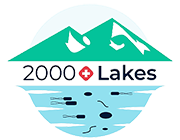The Project
Alpine lakes and climate change
Alpine lakes located above the 2000-meter tree line are excellent indicators of climate change because their chemistry and biology respond quickly to environmental changes. The microorganisms that live in these ecosystems constantly adapt to changing environmental conditions and play essential ecological roles such as contributing to the global biogeochemical cycles. Little is known however on the diversity and functioning of microbial communities in alpine lakes exposed to climate change, and what may be the impacts of global warming on ecosystem functioning. The Swiss Alps are home to more than 1500 alpine lakes whose microbial life is understudied.
Goal of the project
The project has two main goals: firstly, to describe the microbial and functional diversity of high mountain lakes in Switzerland by describing their microbiome. Secondly, we aim to involve the public in our scientific research and raise awareness of the importance of the preservation of the alpine environment.
The microbiology of climate change
Climate change microbiology is an emerging area of research aiming to understand the microbial responses to climatic perturbations and assessing the impact of these responses on ecosystem health and elemental cycles. Thanks to a short generation time and rapid reproduction, microbial communities are readily influenced by environmental changes. Thus, microbial adaptation to climate change has the advantage of being able to be studied over a relatively short period compared to that of larger organisms. The 2000LAKES project will evaluate the community and functional responses of microbial populations in Swiss alpine lakes to environmental changes. The project will provide a better understanding of the microbial diversity of these remote and unique environments.
Citizen science
One of the particularities of this project is to engage in participatory Science. Indeed, the project involves local citizens and associations by inviting them to participate in sampling campaigns in the Swiss Alps. In addition, the project will allow those interested to be immersed in the development of a scientific project, to understand its progress and to be made aware of the richness of the microbial diversity of the Swiss alpine lakes. Finally, it will also serve as a space for dialogue around environmental research and conservation. In addition to raising public awareness of the challenges of the project, participatory science aims to take advantage of this collaboration by taking into account everyone's motivations, skills and expectations.
Sampling campaigns
Two groups of sampling campaigns will be carried out over one year with a first in winter/spring and a second in summer. In addition to the samples, essential physico-chemical parameters will be measured in situ in order to complete the research. The samples obtained will be genetically analyzed in order to characterize the sites by their metagenome (all the genetic material of the samples). Bacteria will also be isolated and cultured in order to create a culture collection of alpine bacteria that can serve research and conservation purposes. Currently, the “MicrobiAlps” collection already counts more than 200 species isolated from 24 different lakes located in the Swiss alps.
